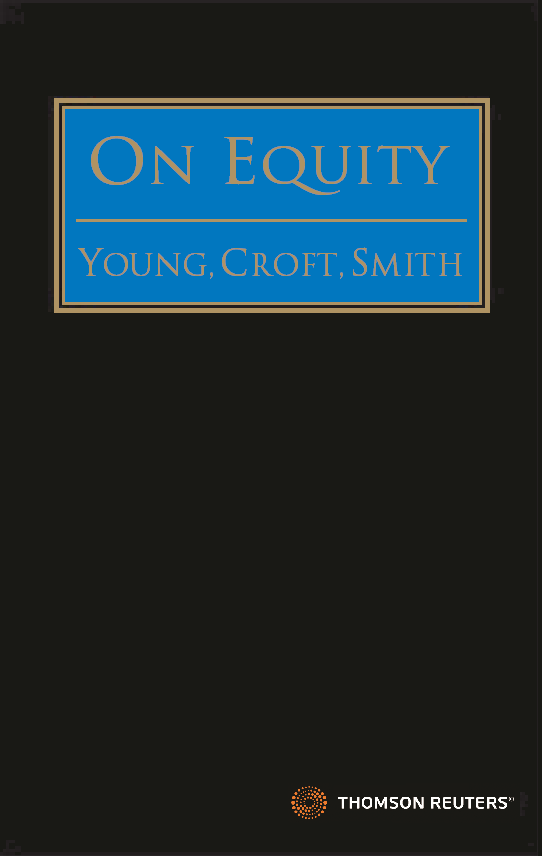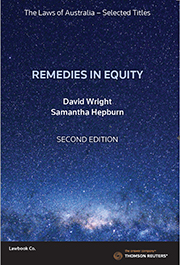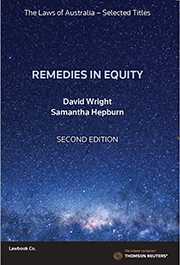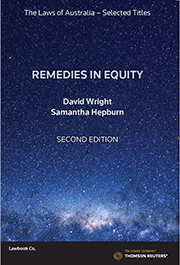
On Equity (Softcover)
|
Book $102.40* $256.00 RRP Save: $153.60 (60%) |
Date: 18/08/2009 Code: 9780455225081 Lawbook Co., AUSTRALIA |

On Equity (Softcover)
Sale Price: $102.40
Saving: $153.60 |
Available Formats
| Format | Title | Date | Code | Price | |
|---|---|---|---|---|---|
| Book | On Equity (Softcover) | 18/08/2009 | 9780455225081 | $102.40 |
Add to cart

On Equity (Softcover)
Sale Price: $102.40
Saving: $153.60 |
Description
On Equity is a thorough and commanding examination of the practice and principles of equity, written by the the Honourable Justice Young, former Chief Judge in Equity of the Supreme Court of NSW from 2001–2009 and currently a Judge of Appeal of the Supreme Court of NSW and two distinguished co-authors.
By providing a fresh treatment of equitable doctrines and remedies, this seminal work will ensure that practitioners and students of law have an essential and accessible model for equity in the 21st century.
The distinguished authors explore the practice of equity and the day-to-day business of equity practitioners and elucidate the underlying principles in a clear and readable manner.
On Equity authoritatively explores the history of equity, equitable doctrines and equitable remedies in three parts:
• HISTORY AND OVERVIEW
Introduction, Fundamental Concepts, Maxims and Practical Applications of Equity
• EQUITABLE DOCTRINES
Fraud, Trusts, Fiduciary Relationships, Property, Mortgages, Equitable Assignments, Contracts, Miscellaneous Equities, as well as the principles governing Probate and Administration of Estates
• EQUITABLE REMEDIES
Discussion on Remedies, Equities and Procedure, Usual Remedies, Defences in Equity, Restitution, New Developments and the Future
On Equity is destined to become a leading work in its field.
Recently cited in:
Burns v Grevler [2010] NSWSC 1219 at [85] per Rein J.
85 I accept that it is important for the Court not to seize upon a conflict of interest and work backwards to conclude that there must therefore be a fiduciary obligation: see Breen at 109 per Gaudron and McHugh JJ and Ausintel Investments Australia Pty Ltd v Lam (1990) 19 NSWLR 637, discussed in P W Young, C Croft and M L Smith, On Equity (2009), Thomson Reuters, Sydney at [7.80].
Sewell v Zelden [2010] NSWSC 1180 at [81] per Rein J.
81 The law in relation to benefits obtained by third parties in the context of a breach of trust or fiduciary duty has come under close scrutiny in recent times. Much judicial and extra-judicial consideration has been given to the topic, and I will attempt to distil the principles binding on this Court and relevant here (see Consul Development Pty Limited v DPC Estates Pty Limited (1974) 132 CLR 373 and Farah Constructions Pty Limited v Say-Dee Pty Limited (2007) 230 CLR 89), acknowledging the assistance of P W Young, C Croft and M L Smith, On Equity (2009), Thomson Reuters, Sydney (see [6.880]-[6.910])
You Might Also Like
-

Remedies in Equity 2nd Edition - The Laws of Australia Bo...Book
$202.00 $80.80
-

Remedies in Equity 2nd Edition - The Laws of Australia Bo...Book+eBook
$262.00 $104.80
-

Remedies in Equity 2nd Edition - The Laws of Australia eB...eBook - ProView
$202.00 $80.80
Editorial Reviews
From: Bar News, Summer 2009/2010
Reviewed by Mark Speakman SC
Fourthly, On Equity places considerably more emphasis on the procedure of equity than do other Anglo-Australian texts.
Fifthly, and by no means least, On Equity is crisply written, in an accessible style and format. There is great clarity on many fundamental principles of equity.
The final chapter of On Equity looks at new developments and the future of equity. A large ‘chunk’, under the heading ‘equity in a Fast-Changing World’, is an updated version of the paper presented by Lord Browne-Wilkinson in 1996.
Young, Croft and Smith then discuss the future of equity under the heading ‘Whither equity?’. That has been the title of the several papers given over the last 50 years about the future of equity. Young, Croft and Smith note four principal developments over the last 20 years. First, equity has become much more involved with commercial transactions. Secondly, there have been new developments in constructive trusts. Third, there has been a return to considering conscience as the basic principle of equity. Fourth, there has been the challenge to ‘traditional equity’ by ‘academics of the restitutionist school …’ The authors conclude that ‘equity is not beyond the age of child-bearing – she continues to produce many and varied offspring’.
Of particular interest to Bar News readers is On Equity’s proposition that New South Wales ‘may well be’ the place for the growth of equity. The authors contend that the New South Wales equity Bar is the primary producer of the judges of superior courts and its members ‘think equity’’. The authors concede that it is ‘really foolish to attempt to predict what developments might occur’. However they cautiously predict that basic principles will continue to be observed, but will be applied to deal with new social situations.
1. ‘Equity’s Australian Isolationism’ (2008) 8 QUTLJ 444.
Resource Downloads
Product Reviews
- Review: ABFLB June/July 2010 [PDF 94180]
- Review: Bar News, Summer 2009-2010 [PDF 62310]
- Review: Ethos March 2010 [PDF 14020]
- Review: Hearsay Issue 41 May 2010 [PDF 42650]
- Review: Law Institute Journal April 2010 [PDF 188040]
- Review: Supreme Court of Qld Library, March 2010 [PDF 136720]
 Equity
Equity